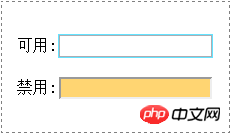 Web Front-end
Web Front-end
 CSS Tutorial
CSS Tutorial
 What are disabled and enabled? Detailed explanation of disabled and enabled attributes
What are disabled and enabled? Detailed explanation of disabled and enabled attributes
What are disabled and enabled? Detailed explanation of disabled and enabled attributes
The content of this article is about what are disabled and enabled? The detailed explanation of disabled and enabled attributes has certain reference value. Friends in need can refer to it. I hope it will be helpful to you.
What are disabled and enabled? Detailed explanation of disabled and enabled attributes
In web forms, some form elements (such as input boxes, password boxes, check boxes, etc.) have two states: "available" and "unavailable". By default, these form elements are available.
In CSS3, we can use the :enabled selector and :disabled selector to set the CSS styles of the form elements in the available and unavailable states respectively.
Example:
<!DOCTYPE html>
<html xmlns="http://www.w3.org/1999/xhtml">
<head>
<title>CSS3 :enabled选择器与:disabled选择器</title>
<style type="text/css">
input[type="text"]:enabled
{
outline:1px solid #63E3FF;
}
input[type="text"]:disabled
{
background-color:#FFD572;
}
</style>
</head>
<body>
<form>
<p><label for="enabled">可用:</label><input type="text" name="enabled"/></p>
<p><label for="disabled">禁用:</label><input type="text" name="disabled" disabled="disabled"/></p>
</form>
</body>
</html>Analysis:

Here we add an outline outline to the text box in the "available" state, and then Changes the background color of text boxes in the "disabled" state.
The above is about what are disabled and enabled? The disabled and enabled attributes are explained in detail. If you want to know more about CSS3Tutorial, please pay attention to the PHP Chinese website.
The above is the detailed content of What are disabled and enabled? Detailed explanation of disabled and enabled attributes. For more information, please follow other related articles on the PHP Chinese website!

Hot AI Tools

Undresser.AI Undress
AI-powered app for creating realistic nude photos

AI Clothes Remover
Online AI tool for removing clothes from photos.

Undress AI Tool
Undress images for free

Clothoff.io
AI clothes remover

AI Hentai Generator
Generate AI Hentai for free.

Hot Article

Hot Tools

Notepad++7.3.1
Easy-to-use and free code editor

SublimeText3 Chinese version
Chinese version, very easy to use

Zend Studio 13.0.1
Powerful PHP integrated development environment

Dreamweaver CS6
Visual web development tools

SublimeText3 Mac version
God-level code editing software (SublimeText3)

Hot Topics
 1385
1385
 52
52
 Working With GraphQL Caching
Mar 19, 2025 am 09:36 AM
Working With GraphQL Caching
Mar 19, 2025 am 09:36 AM
If you’ve recently started working with GraphQL, or reviewed its pros and cons, you’ve no doubt heard things like “GraphQL doesn’t support caching” or
 Building an Ethereum app using Redwood.js and Fauna
Mar 28, 2025 am 09:18 AM
Building an Ethereum app using Redwood.js and Fauna
Mar 28, 2025 am 09:18 AM
With the recent climb of Bitcoin’s price over 20k $USD, and to it recently breaking 30k, I thought it’s worth taking a deep dive back into creating Ethereum
 Vue 3
Apr 02, 2025 pm 06:32 PM
Vue 3
Apr 02, 2025 pm 06:32 PM
It's out! Congrats to the Vue team for getting it done, I know it was a massive effort and a long time coming. All new docs, as well.
 Can you get valid CSS property values from the browser?
Apr 02, 2025 pm 06:17 PM
Can you get valid CSS property values from the browser?
Apr 02, 2025 pm 06:17 PM
I had someone write in with this very legit question. Lea just blogged about how you can get valid CSS properties themselves from the browser. That's like this.
 A bit on ci/cd
Apr 02, 2025 pm 06:21 PM
A bit on ci/cd
Apr 02, 2025 pm 06:21 PM
I'd say "website" fits better than "mobile app" but I like this framing from Max Lynch:
 Comparing Browsers for Responsive Design
Apr 02, 2025 pm 06:25 PM
Comparing Browsers for Responsive Design
Apr 02, 2025 pm 06:25 PM
There are a number of these desktop apps where the goal is showing your site at different dimensions all at the same time. So you can, for example, be writing
 Stacked Cards with Sticky Positioning and a Dash of Sass
Apr 03, 2025 am 10:30 AM
Stacked Cards with Sticky Positioning and a Dash of Sass
Apr 03, 2025 am 10:30 AM
The other day, I spotted this particularly lovely bit from Corey Ginnivan’s website where a collection of cards stack on top of one another as you scroll.
 Using Markdown and Localization in the WordPress Block Editor
Apr 02, 2025 am 04:27 AM
Using Markdown and Localization in the WordPress Block Editor
Apr 02, 2025 am 04:27 AM
If we need to show documentation to the user directly in the WordPress editor, what is the best way to do it?



